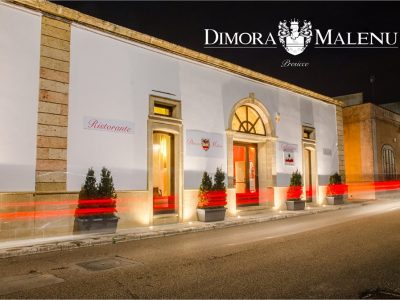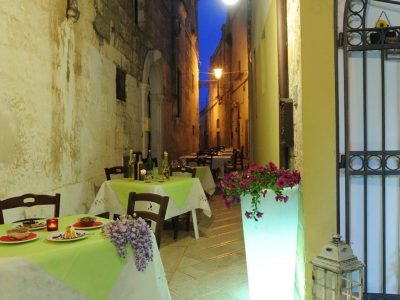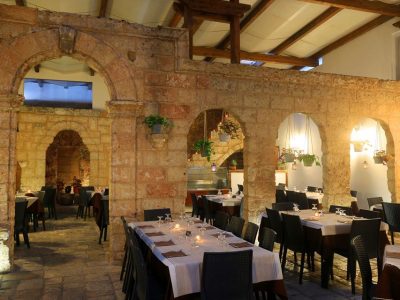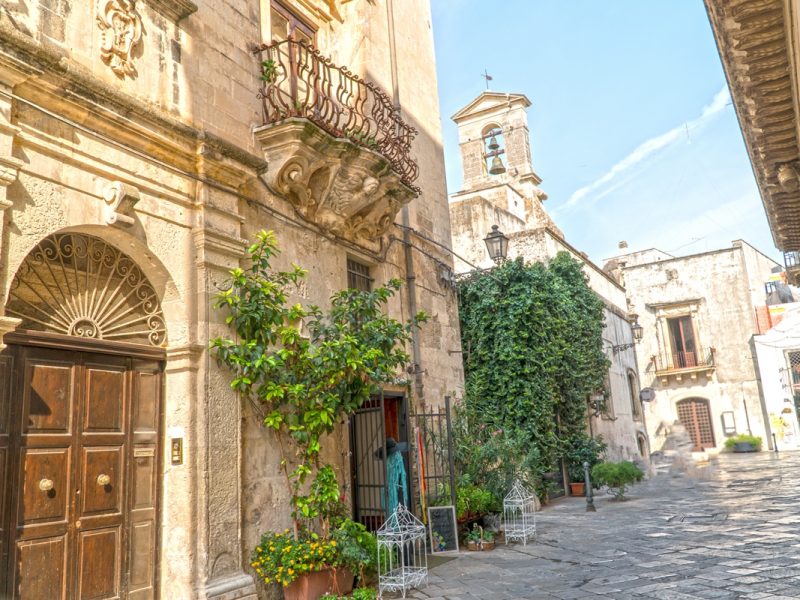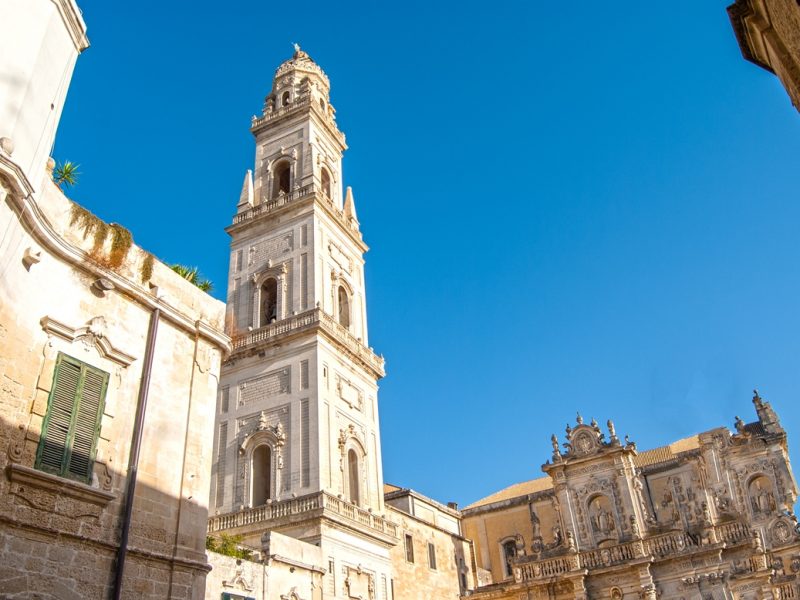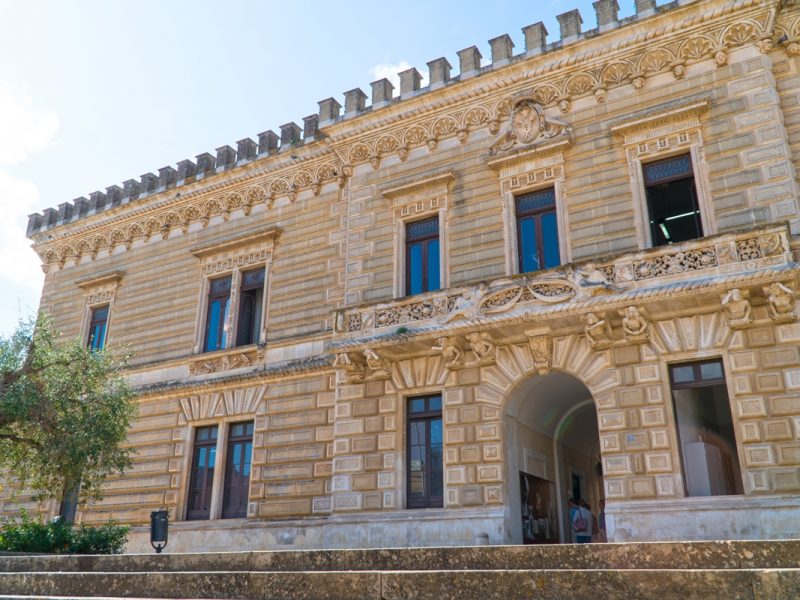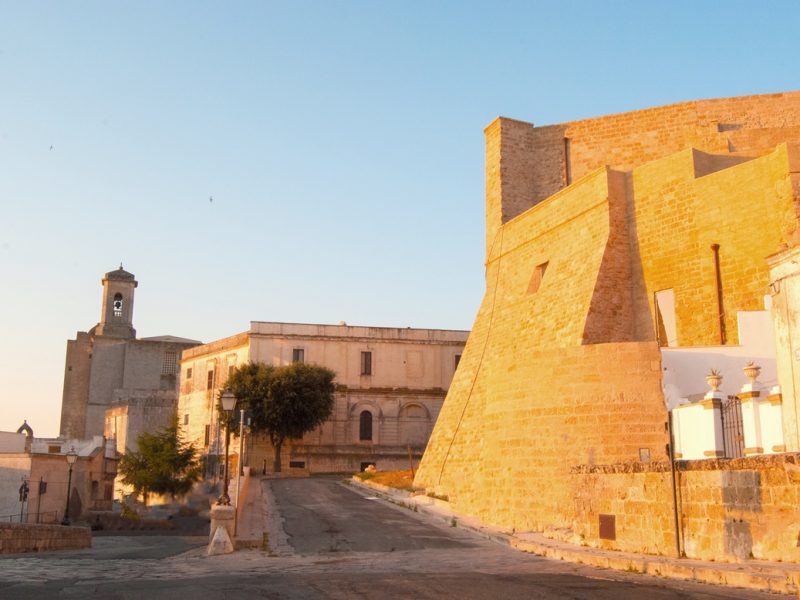The Borgo of Presicce
The rocky, boulder formation hills of the “serra” of Pozzomauro embrace the little town of Presicce, protecting it from the west wind and cradling it in a mild, pleasant climate.
Presicce is a town of twin souls, with traces of its dual past still evident in the ancient stone streets of the historical center. In via Gramsci (Gramsci street), the main street, the deep royal red of the elegant noble homes narrate tales of noblemen from times past who frequented the Palace of the Marquis (Palazzo Marchesale), chatting languorously in the shade of the fragrant wisteria in the Italian garden, looking down from their “belvedere” terrace upon the Piazza of Sant’Andrea, with its elegant Baroque church. Meanwhile, in Piazza del Popolo (The People’s Square), directly facing the Palazzo Marchesale, we find the first of many “frantoi ipogei”, the subterranean olive mills dispersed throughout the historical center. You can still imagine the pungent aroma of the olive oil, the petroleum black of the olives being crushed into paste in the stone grinding wheel of the olive press, the clopping of the mules’ hooves as they circle round and round, the living motor of the olive mill. You can still hear the women chatting on their stoops as they wait for their fathers and husbands to return from the olive mills. An arch of carved stone was the entrance to the shared courtyard and stone houses where the farmers and oil producers lived all together, in modest homes with milk-white doors painted in plaster, homes of a community that shared everything, from the stone washboards to the stalls for their animals, where the doors were never closed, remaining open to offer help and solidarity to all.
This is the true essence of Presicce, land of olive oil and “frantoi”, the olive mills.
Frantoi ipogei, the subterranean olive mills
Today, the patrimony of Presicce has the golden color of olive oil, known for its velvety flavor and pungent aroma, but in the past, its olive oil was black and strong and was used as lamp oil.
Behind every olive oil produced in Salento there is a story of farmers, olive producers, and above all, of the frantoi, the olive mills, dispersed throughout the territory, a story that in Presicce reaches its maximum expression in a grand and heroic tale of artisans, craft and courage.
The natural stone embankments of the “serra” di Pozzomauro were home to the first subterranean olive mills, safe underground, dug with their bare hands, testimony of the small, determined community that was able to resist, with great difficulty, the onslaught of the Ottoman (Saraceni) invasion.
As time passed, the intensified production of olive oil required increased organization, and the population in the hills of Pozzomauro decided to move operations down to the valley below along the “via pubblica”, the Public Road, where most of the subterranean olive mills of Presicce are still found today.
Problems such as water infiltration and unhygienic conditions led to the eventual disuse of the ancient frantoi, but Presicce has not forgotten its origins. The subterranean olive mills have been an integral part of the revaluation of this little borgo, a place of simple pleasures, like the taste of newly pressed oil on fresh, crunchy bread.
Palazzo Ducale, the Palace of the Duke
The commercial activity of olive oil production has been the base of Presicce’s wealth since its very foundation. The Normans were the first to recognize this, and to protect the trade of this precious condiment, they constructed a fortress of foreboding and austere nature.
In the years that followed, the palace became the home of the feudal lords of Presicce, the Gonzaga and lastly, the Liguori, who attempted to remodel the building to soften its features and transform it into an elegant noble home.
The imposing column-supported verandas were enhanced with Baroque decorations and the window frames assumed soft and sinuous forms, but the true jewel of the palace is the Italian garden. Upon entering one of the four majestic portals, one is transported back in time, where noble ladies strolled through the lush and poetic garden, protected by the shade of their pastel umbrellas.
In the center of the garden, under the climbing wisteria, stone columns surround an ancient stone seating area, where you can admire the delicate beauty of this paradise, refreshed by a breeze scented with mandarin and orange blossoms.
The balcony provides a spectacular view of the noble houses and the church of Sant’Andrea, whose Baroque charm beckons visitors with flirtatious elegance.
The Church of Sant’Andrea
The apostle Saint Andrew, or Sant’Andrea apostolo, the patron saint of Presicce, looks down on his flock from high upon his column. The main church of Presicce is dedicated to him, with its intricate Baroque façade and elegant pearl-hued exterior.
The interior is adorned with paintings of artistic importance and an imposing central altar in marble, as well as boasting magnificent baptismal fonts donated by Francesco I of the Bourbons to the illustrious Michele Arditi.
The church of Sant’Andrea was built on the ruins of an earlier church which was seriously damaged in an earthquake in 1743. In response to the calamity, the community joined together to heal the wound inflicted upon their place of worship, and in just a few years were able to inaugurate what is still today their beloved main church. The only architectural survivor of the disaster was the bell tower, crafted in Renaissance style. It was included in the new construction, proudly displaying on high the historic crest of Presicce, symbol of a strong and united community that has never surrendered.
“La Casa Turrita”
“La Casa Turrita”is the most unique building in all of Presicce. It faces via Gramsci, which was once the main street of the borgo, the public road that went in one direction toward the town of Acquarica del Capo and in the other toward Santa Maria di Leuca.
Originally, “la Casa Turrita” was called the “Torre di San Vincenzo”, (the Tower of St Vincent). It was constructed in the first half of the XV century as a part of a defensive structure which included two other towers. Its severe exterior was later softened to render it more similar to the aesthetic of a noble residence. The unique characteristic of this palace is the façade, which is embellished with an unusual pattern of diamond-point sculptural elements. It has been recently restored, but it has conserved many of its original architectural features.
Chiesa di Santa Maria degli Angeli, the Church of Saint Mary of the Angels
Outside the city walls, we find the church of Santa Maria degli Angeli, Saint Mary of the Angels, a sacred structure of simple and rigorous lines, built at the end of the 600’s by reformist priests living in a nearby monastery.
The little church is on the route of the “via Francigena” a road of pilgrimage, originating in France, which leads pilgrims all the way to the Sanctuary of the Madonna in the coastal town of Santa Maria di Leuca, at the southernmost tip of Salento. Despite its invaluable historic and religious importance, the church was looted, depriving it of the artistic beauty its founding priests had originally adorned it with. Today, it safeguards a wooden altar of enchanting beauty, a carved crucifix portraying Cristo Patiens, and several frescos.
Recent restorations have brought to light various Byzantine frescos with designs painted in gold, compensating, in part, for the past wrongs committed against this fascinating place.
Popolo di Mascarani, the Masked People
The ius primae noctis (the law imposed on the population by the nobility, forcing the bride to be “escorted” to her wedding by the reigning prince or noble, who had the right to “sample the goods” and defile her virginity before her marriage to a common man) is one of the most discussed and controversial practices of the Middle Ages. Some contend that it is just legend, while others insist that it was an actual practice, enforced until recent times. True or false as it may be, this medieval practice is closely woven into the history of Presicce.
The elders recount a legend, passed word of mouth from generation to generation, of a young man in love and his newly-wed bride, who was forced to submit to the Duke of the time, in keeping with the ancient privilege he insisted on enforcing. Love made it impossible to accept such an outrageous offence, and so the young husband took advantage of the celebrations at Carnival time and, masked in the crowd, waited for the Duke to look out from his balcony, shot him, and then disappeared in the sea of masks, leaving the offending Duke to flounder in his agonized death. It is because of this story of blood and honor that the people of Presicce are known throughout Salento by the nickname of “the Masked Ones”, the Mascarani.
Michele Arditi
Michele Arditi is the most illustrious citizen ever born in Presicce.
Cultured, well-read, and a great intellectual, he studied Law in Naples, but his true passion was archeology: a seed planted within him by Neopolitan Reformism, and norished by his fascination for the archeological digs of Erocolano and Pompei.
Dazzled and enthralled by the Enlightenment movement, he became one of the most important scholars of the Kingdom of Naples and beyond. The letters he exchanged with the important personalities of the day are vibrant with the immense, infinite, and transcendent love for his studies and research, his work as the director of the Museum of Naples and the supervisor of the archeological digs of Pestum.
In his quest for fertile cultural terrain and souls thirsty for knowledge, he purchased the feudal territory of Castelvetere, where he created a rarified environment to continue his passionate studies, and was ordained by the King of Naples with title of Marquis.
The light of his culture was extinguished in Naples in 1838, where he still rests today, in the Church of Saint Sebastian, in a tomb carved for him by the master sculptor Antonio Canova.
Do you know typical recipes of this borgo? Contact us!

 Italiano
Italiano
 Deutsch
Deutsch










